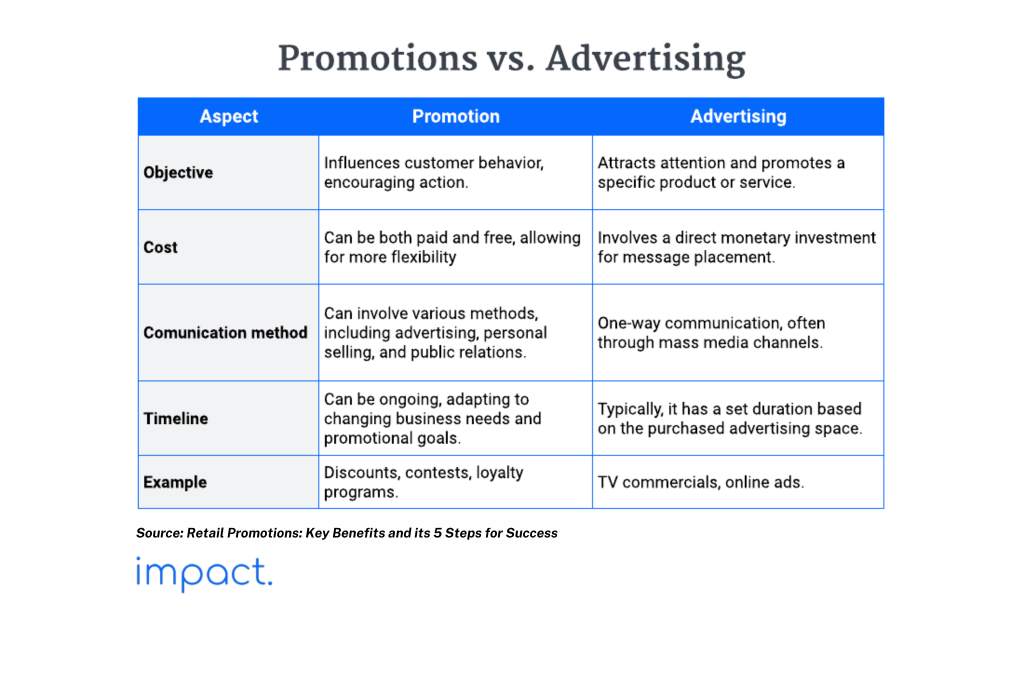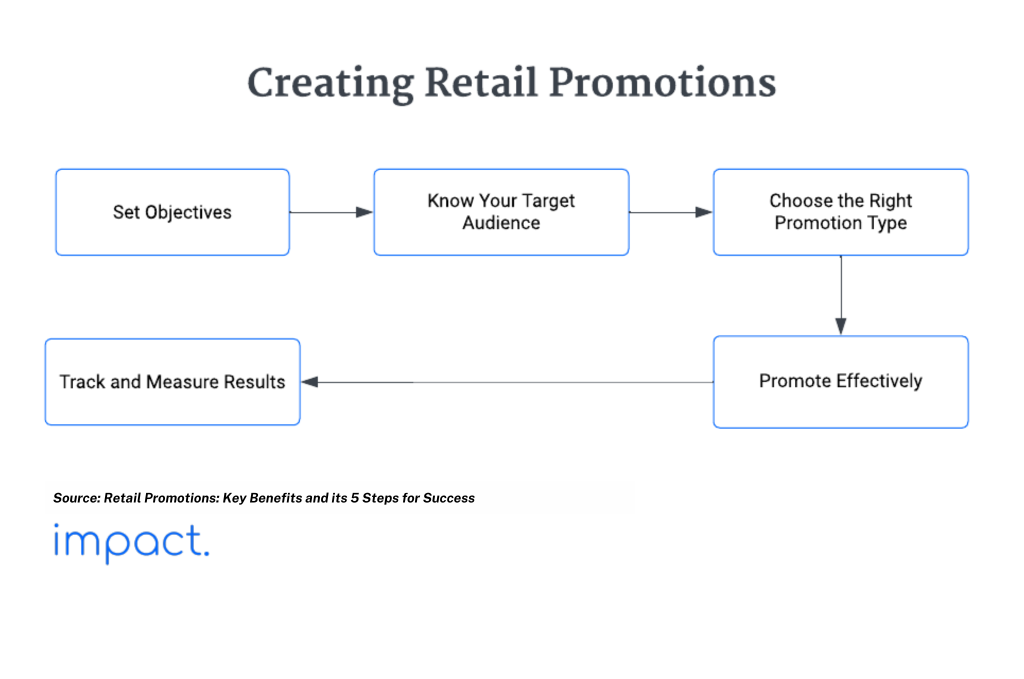Kanban: Definition, 6 Rules, and its Benefits
Kanban is a crucial part of the Just in Time (JIT) system, which we discussed…
Sean Thobias
May 17, 2025The previous chapter explored how advertising brings customers to your store. Now, let’s dive into retail promotion, which, as Dan Ramsey explains in “The Everything Guide to Starting and Running a Retail Store,” includes all paid or free efforts to get customers to act.
This guide will show you how to run a successful retail promotion, outline various strategies, and provide best practices for effective retail promotion.
Advertising and promotion are terms often used interchangeably, but advertising is just one part of promotion.
Promotions are like short ads, offering consumers incentives like free products, coupons, discounts, or risk-free trials. By providing reasons to shop with you, customers are more likely to act impulsively and sign up for your offerings.

Retail promotions bring in more customers and boost immediate sales, increasing conversion rates and average transaction values. A survey shows that 93% of U.S. shoppers consider discounts and offers crucial in buying from a retailer or brand.
Use promotions to encourage customers to buy more or try different products. For example, a buy-one-get-one (BOGO) offer can inspire customers to add extra items to their cart. Additionally, promotions attract new customers who might have hesitated to try your products or services at the regular price.
When you have products that aren’t selling well or have too much stock, retail promotions are a quick way to get those items off the shelves. It is beneficial for seasonal items like holiday decorations or summer clothes, which may not sell as well after a specific time.
Using promotions to offer discounts or bundles on seasonal products helps generate interest and boost sales during specific seasons or events. This approach allows retailers to make the most of their sales opportunities while reducing the chances of having leftover unsold inventory.
Effective retail promotions build customer loyalty. When you consistently offer value through promotions, customers feel appreciated and become loyal.
When customers feel valued and rewarded, they stick with your brand. This loyalty leads to repeat purchases, providing steady revenue and reducing the need to attract new customers constantly.
Promotions reflect our love for good deals and the fear of missing out. Impulse buys happen when people are drawn to a fantastic deal or worry about losing out on a limited-time offer.
Retailers can capitalize on these impulsive tendencies by making promotions feel scarce or exclusive.
Retail promotions offer a chance to gather important customer data. Customers who engage with promotions might join loyalty programs, subscribe to newsletters, or share information while purchasing.
Utilizing this information allows for refining target audience segmentation, crafting personalized promotions, and enhancing the effectiveness of future marketing strategies.
Discounts involve temporarily reducing the regular price of a product or service, either by a fixed amount or a percentage of the original price.
When deciding on discounts, consider whether they should apply to the entire store or specific products. While a storewide discount attracts attention, choose the option that aligns with your business strategy.
Pros:
Cons:
BOGO promotions mean you get a free or discounted item when you buy a specific item at the total price. Customers love these deals because they make spending money feel less guilty, giving them a sense of getting more for their bucks.
Highlight your BOGO offers prominently to ensure customers are aware of the offer. Verify that your stock can accommodate increased sales and simplify the retail promotion for easy customer participation.
Pros:
Cons:
Coupons are vouchers or codes that give discounts when used for purchases. They can be given out in print, digital, or mobile apps and be single-use or reusable.
Consider sending virtual coupons to first-time or big-spending customers. A coupon in their inbox makes customers feel special and prompts them to return to your store.
Pros:
Cons:
A loyalty program is a way businesses encourage customers to return by giving them rewards. These rewards can be things like discounts, points, or special perks.
To start a retail loyalty program, make a straightforward points system. Encourage people to join, provide personalized deals, keep them informed about their points, and improve the experience with technology such as mobile apps or digital cards.
Pros:
Cons:
Businesses create seasonal retail offers as special deals for holidays or events, aligning with when people usually desire specific products.
To implement these offers effectively, companies adjust their marketing strategies to match the season, create deals relevant to that time, modify product displays, use seasonal images, and promote the offers in various ways.
Pros:
Cons:
Bundle promotion involves combining various products or services and selling them together at a discounted price. The idea is to encourage customers to purchase multiple items, making them feel they’re getting a great deal and spending more while also helping the store sell specific inventory.
To implement a successful bundle promotion, the store should carefully select complementary products, create appealing package deals, highlight the cost savings to customers, and set prices that make the bundle more enticing than buying items individually.
Pros:
Cons:
In a retail store, collaboration and partnership promotion means teaming up with other businesses to create marketing strategies that benefit everyone involved. It includes working together to promote products, share customer bases, and use each other’s strengths to boost visibility and sales.
To implement this, a retail store can forge alliances with businesses that complement its offerings. It might involve co-hosting events, promoting each other’s products, or giving discounts to customers who support both businesses.
Pros:
Cons:

State the goal of your promotion upfront. Here are some common objectives:
Ensure your retail promotion goals are SMART—specific, measurable, achievable, relevant, and time-bound. For instance, set a particular percentage increase target within a defined time frame to increase your sales.
Customize your retail promotions to suit your target audience, leading to better outcomes. By grasping what your audience likes, you can craft promotions that resonate with them, making it more likely for them to get involved and make purchases.
Examine customer details such as demographics, preferences, and behaviors. Take into account factors like age, gender, income, and location. This understanding enables you to design promotions that align with their interests, increasing their engagement and purchasing chances.
Choosing the right retail promotion depends on your goals and what your target audience likes. Different promotions work for other customers:
Once you’ve decided on the promotion type, use a mix of marketing channels to reach your audience. This could include:
Read more: Unlocking Growth: 19 Traction Channels for Business Success
Set up a system to track important metrics for your goals. Monitor sales, customer engagement, and foot traffic during promotions. Analyze the data to see how well the promotion worked and find ways to improve it.
Get feedback from customers to learn about their experiences and preferences. Use this information to improve your strategies for future promotions and make your marketing strategy more effective.
Complicated promotions can confuse customers and make them less likely to join in. Keep retail promotions simple and easy to understand to boost participation, increasing customers’ chances to remember and act on them.
For instance, simplify sales promotion emails by focusing on the deal, adding a clear call-to-action button, and avoiding unnecessary text. This makes it easy for customers to click through and redeem the promotion.
In the ever-changing world of retail, consumer choices are influenced by many things. If a promotion isn’t working as expected, it’s vital to adapt quickly. Regularly monitor metrics, use A/B tests, and adjust your strategy to avoid wasting time on ineffective marketing and respond promptly to market changes.
Use software and analytics tools to assess your retail promotions’ performance quickly. Measure important factors like sales, customer engagement, and return on investment to determine what’s working and what’s not.
With this data-driven insight, you can make smarter decisions for future promotions, making your marketing strategy more effective.
Don’t stop promoting after customers buy. Besides getting new customers, ensure the ones you already have are happy and want to return.
Map out the customer journey to understand their thoughts, actions, and feelings during buying. Identify areas for improvement, like better customer service, a smoother checkout, or regular communication to keep customer relationships strong.
In the competitive retail landscape, promotions are crucial for success. Integrating a dedicated promotions tool enhances strategies, unlocking more potential and offering valuable insights for better analysis and decision-making.
Use an ERP system to see your inventory, sales, and customer information. This helps you decide on promotions using accurate data, avoiding stockouts or overstock situations. Next, we’ll explore adding profitable lines and expanding your retail store.
Ramsey, D., & Ramsey, J. (2010). The Everything Guide to starting and running a retail store: All you need to get started and succeed in your own retail adventure. Adams Media.
Impact Insight Team
Impact Insights Team is a group of professionals comprising individuals with expertise and experience in various aspects of business. Together, we are committed to providing in-depth insights and valuable understanding on a variety of business-related topics & industry trends to help companies achieve their goals.
See how our ERP provides better value.
Speak with our consultant to explore how we can improve your accounting, processes, and people.
